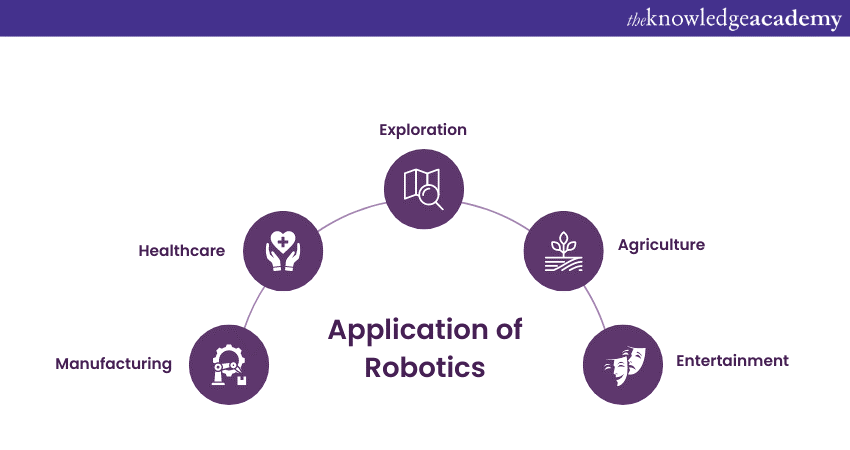We may not have the course you’re looking for. If you enquire or give us a call on 01344203999 and speak to our training experts, we may still be able to help with your training requirements.
Training Outcomes Within Your Budget!
We ensure quality, budget-alignment, and timely delivery by our expert instructors.

The roots of Robotics trace back to ancient civilizations' mythologies and automata. However, it was in the mid-20th century that true Robotics began to take shape. The term "Robotics" was coined by Isaac Asimov in the 1940s, and the first industrial robot, Unimate, was introduced in the 1960s, marking the beginning of modern Robotics. Since then, Robotics has witnessed remarkable advancements in technology and diverse applications.
The future of automation is Robotics, the field of study and development of autonomous machines that can perform tasks with human-like capabilities. From manufacturing industries to healthcare, from exploration of distant planets to our daily lives, Robotics has found its place as an indispensable tool. In this blog, we will discuss What is Robotics, exploring its definition, key components, applications, and the exciting prospects it holds for the future.
Table of Contents
1) Definition of Robotics?
2) Key components of Robotics?
a) Sensors
b) Processors
c) Actuators
d) End effectors
3) Application of Robotics
a) Manufacturing
b) Healthcare
c) Exploration
d) Agriculture
e) Entertainment
4) Future of Robotics
a) Advancements in AI and ML
5. Conclusion
Definition of Robotics?
Robotics can be defined as the interdisciplinary field that encompasses the design, construction, operation, and use of robots. A robot, in this context, is a programmable machine capable of carrying out tasks autonomously or semi-autonomously, often mimicking human actions and interactions. These machines can be remotely controlled or operate independently through a combination of sensors, processors, actuators, and programming.
Learn more about Robotic Devices Training today and kickstart your career!
Key components of Robotics?
In the world of Robotics, the seamless structure of various components enables machines to come alive, mimic human actions, and perform tasks that were once confined to our imagination. Let's understand the key components that form the backbone of every robot:

Sensors
Imagine a robot as a curious explorer, eager to understand and interact with its surroundings. Sensors are the sensory organs that empower robots with this capability. They provide the crucial link between the digital and physical realms, allowing robots to perceive the world around them.
a) Cameras: Vision is paramount for robots to comprehend their environment. Cameras capture visual data, enabling robots to identify objects, detect movement, and even navigate autonomously.
b) Ultrasonic sensors: These sensors use sound waves to measure distances, helping robots avoid obstacles and providing a sense of spatial awareness.
c) Infrared sensors: Detecting heat signatures, infrared sensors are used in various applications, from identifying warm bodies in medical imaging to temperature monitoring in industrial settings.
d) Touch sensors: Comparable to our sense of touch, these sensors allow robots to interact with objects delicately and sense pressure or force.
e) Depth Sensors: Using techniques like structured light or time-of-flight, depth sensors measure the distance to objects, enabling robots to create three-dimensional maps and navigate complex spaces.
f) Microphones: These sensors detect sound waves and enable robots to process auditory information. They are utilised in scenarios like voice recognition and detecting environmental noises.
g) Pressure sensors: These sensors measure force or pressure applied to a surface. They are crucial for robotic hands and grippers to exert appropriate force when handling delicate objects.
h) Force sensors: Force sensors gauge the force exerted during interaction, enabling robots to execute tasks that require precise manipulation, such as assembly and surgery.
Processors
The processors in a robot can be likened to its brain, processing the influx of data from sensors and making informed decisions based on algorithms and programming.
a) Microcontrollers and microprocessors: These are the computing powerhouses that process data and execute commands. As technology advances, processors become more efficient, enabling quicker and smarter decision-making.
b) Artificial Intelligence (AI): AI Robots installed with the capacity to learn from their experiences and adapt to different scenarios. Machine learning algorithms enable robots to improve their performance over time.
c) Control algorithms: These algorithms dictate how a robot responds to specific inputs, ensuring precise and coordinated movements.
d) Neural networks: Inspired by the human brain, neural networks are employed in AI-driven Robotics for tasks such as image recognition, natural language processing, and decision-making.
e) Kinematics and dynamics: These algorithms define how a robot moves its limbs and manipulates objects. They consider factors like joint angles, velocities, and external forces.
f) Path planning: Path planning algorithms determine the optimal route a robot should take to navigate from one point to another while avoiding obstacles and considering environmental constraints.
g) Feedback control: Feedback loops use sensor data to regulate a robot's actions in real-time, enabling precise movements and adjustments to change conditions.
h) Speech and language processing: Processors equipped with AI capabilities can interpret human speech, enabling robots to understand and respond to verbal commands.
i) Gesture recognition: Powerful processors decode human gestures, allowing robots to interpret non-verbal communication cues and respond accordingly.
Actuators
Actuators are the muscles of a robot, converting digital commands into tangible movements and actions in the physical world.
a) Electric motors: Widely used in various robots, electric motors generate rotational or linear motion, allowing robots to move their limbs, wheels, and other parts.
b) DC motors: Direct current (DC) motors are commonly used in Robotics due to their simplicity and precise control. They are ideal for applications where accuracy and variable speed are crucial.
c) Stepper motors: Stepper motors move in discrete steps, making them suitable for tasks that require precise positioning, such as 3D printing and CNC machining.
d) Brushless motors: These motors offer higher efficiency and reliability compared to brushed motors, making them well-suited for tasks that demand continuous and high-speed motion.
e) Pneumatic and hydraulic actuators: These act as strong and precise sources of force. Pneumatic actuators use compressed air, while hydraulic actuators rely on pressurized fluid to drive movements.
End effectors
Analogous to our hands, end effectors are the tools that enable robots to perform specific tasks with precision.
a) Grippers: These versatile tools allow robots to grasp, hold, and manipulate objects of varying sizes and shapes.
b) Lasers: Laser-based end effectors are employed for cutting, engraving, and even scanning in industries like manufacturing and healthcare.
c) Welding tools: Robots equipped with welding end effectors excel in industries that require precision welding, reducing human exposure to hazardous environments.
Application of Robotics
Robotics transcends the confines of science fiction, infiltrating virtually every facet of our lives and industries. From the precision of manufacturing floors to the delicate touch of surgical suites, robots have seamlessly integrated themselves into a myriad of applications. Here, we explore the diverse tapestry of how Robotics has transformed various sectors:

Manufacturing
Manufacturing was the cradle where Robotics took its first steps. Today, it remains a bastion of innovation, with robots streamlining production processes, enhancing efficiency, and ensuring consistent quality.
a) Assembly line pioneers: Industrial robots execute repetitive tasks with unfaltering precision. They assemble, weld, paint, and package products, reducing errors and enabling mass production at unparalleled speeds.
b) Quality control guardians: Robots equipped with sensors inspect products for defects, ensuring only flawless items make their way to consumers.
c) Collaborative manufacturing: Collaborative robots (co-bots) work alongside human operators, contributing to intricate tasks that demand human-like dexterity and decision-making.
d) Complex geometries: Robots in 3D printing create objects with intricate designs that traditional manufacturing methods struggle to produce.
e) Customisation: Additive manufacturing enabled by robots allows for cost-effective production of customised products.
f) Safe and efficient transport: Robots optimise the movement of raw materials and finished products, reducing the risk of human injury.
g) Continuous operation: Robots operate tirelessly, improving efficiency in material handling tasks that are time-consuming for humans.
h) Predictive maintenance: Robots equipped with sensors monitor their own condition, allowing for proactive maintenance and reducing downtime.
i) Data-driven decision-making: Manufacturing processes are optimised through real-time data analysis, enhancing efficiency and reducing waste.
Healthcare
In the ecosystem of healthcare, Robotics has revolutionised diagnostics, treatment, and patient care.
a) Surgical precision: Surgical robots provide surgeons with enhanced dexterity, precision, and minimally invasive capabilities, resulting in quicker recovery times and reduced scarring for patients.
b) Rehabilitation partners: Robotic exoskeletons aid in physical therapy, guiding patients through exercises and assisting in their recovery from injuries or disabilities.
c) Pharmaceutical assistance: Robots automate tasks like drug dispensing, sample handling, and laboratory analysis, ensuring accuracy and reducing human error.
d) Remote surgery: Teleoperated surgical robots allow surgeons to operate on patients located far away, breaking down geographical barriers in healthcare.
e) Muscle stimulation: Robotic devices stimulate muscles to prevent atrophy and improve muscle strength in patients with limited mobility.
f) Laboratory automation: Robotic arms handle and analyse samples, reducing the risk of contamination and expediting diagnostic processes.
g) Remote monitoring: Robots equipped with cameras and sensors enable doctors to remotely assess patients' conditions, enhancing follow-up care.
h) Tele-consultations: Robots provide a platform for patients to communicate with medical professionals, making healthcare accessible beyond geographical boundaries.
Exploration
The cosmos beckons, and robots are at the forefront of our quest to explore the universe beyond our planet.
a) Planetary pioneers: Rovers and landers traverse alien landscapes, analysing soil, collecting samples, and transmitting data back to Earth, expanding our understanding of distant celestial bodies.
b) Satellite servicing: Robots are being developed to repair and maintain satellites, prolonging their operational lifespan and reducing the buildup of space debris.
c) Mars exploration: Rovers like Curiosity and Perseverance have traversed the Martian landscape, analysing soil, rock formations, and even searching for signs of past or present life.
d) Lunar exploration: Landers and rovers have ventured to the Moon, probing its geology and aiding in preparations for future human missions.
e) Telescopes: Space-based telescopes like the Hubble Space Telescope capture breathtaking images of distant galaxies, stars, and planets, expanding our understanding of the cosmos.
f) Orbital maintenance: Robots equipped with precision tools can repair, refuel, and even reposition satellites, enhancing their longevity and functionality.
g) Sample collection: Robotic arms and mechanisms gather material from asteroids, comets, and other celestial bodies, providing insights into the early solar system.
h) Extraterrestrial chemistry: Analysing samples from other worlds offers a glimpse into the chemical makeup of these distant environments, enriching our understanding of their history.
Agriculture
Agricultural robots are cultivating the fields of tomorrow, enhancing productivity while addressing the challenges of modern farming.
a) Automated harvesting: Robots adeptly pick crops at optimal ripeness, reducing labour costs and ensuring timely harvests.
b) Precision agriculture: Equipped with sensors and GPS technology, robots monitor crop health, apply fertilisers precisely, and manage irrigation, leading to efficient resource utilisation.
c) Seeding robots: These robots accurately place seeds in the soil at optimal depths and intervals, improving germination rates and crop uniformity.
d) Insect monitoring: Robots equipped with sensors track insect populations, enabling farmers to implement targeted pest control strategies.
e) Crop monitoring: Robotic systems track crop development and growth rates, offering insights into the best time for planting and harvesting.
Entertainment
The world of entertainment has embraced Robotics, captivating audiences with lifelike animatronics and interactive experiences.
a) Theme Park enchanters: Animatronic characters and rides elevate theme park experiences, bringing beloved fictional worlds to life.
b) Robotic companions: Social robots provide companionship and assistance to individuals, especially the elderly and those with special needs.
c) Dance ensembles: Synchronised robotic dancers deliver captivating performances, executing complex routines that mesmerise audiences with their precision and coordination.
d) Music companions: Robots with musical capabilities contribute to live performances, playing instruments, synthesising melodies, and harmonising with human musicians.
e) Virtual Reality (VR) and Augmented Reality (AR): Robots integrated with VR and AR technology create immersive experiences that blend the digital and physical worlds.
f) Interactive robots: Robots engage with audiences, responding to gestures, voice commands, and even emotions, creating personalised and memorable interactions.
g) Robotic artists: Robots with artistic capabilities create intricate paintings, sculptures, and installations, offering a new perspective on creativity.
h) Generative art: Robots equipped with AI generate unique and evolving art pieces, blurring the lines between technology and artistic expression.
Future of Robotics
As we stand at the precipice of an ever-evolving technological era, the trajectory of Robotics holds promises that inspire awe and fuel our curiosity. With breakthroughs in artificial intelligence, material science, and human-robot interaction, the future of Robotics is poised to reshape industries, enhance our lives, and push the boundaries of what machines can achieve.

Advancements in AI and ML
Artificial Intelligence (AI) will continue to be the cornerstone of robotic evolution, enabling machines to learn, adapt, and improve their performance over time.
a) Autonomous decision-making: Robots will become more adept at making complex decisions in dynamic environments, a crucial skill for applications like self-driving cars and disaster response.
b) Learning from experience: Machine learning algorithms will empower robots to learn from their mistakes, refining their actions and responses based on accumulated experiences.
c) Self-driving cars: Autonomous vehicles use AI to analyse their environment and make real-time decisions, promising safer and more efficient transportation.
d) Game playing: AI agents have mastered complex games like Go and Chess, demonstrating the ability to strategies and make intelligent decisions.
Collaborative Robots
The rise of collaborative robots, or co-bots, will usher in an era of human-robot collaboration, enhancing productivity and safety in various sectors.
a) Industrial synergy: Co-bots will work alongside humans in manufacturing, sharing tasks that require precision, strength, or intricate manipulation.
b) Healthcare partners: In healthcare settings, co-bots will assist medical professionals in tasks such as patient care, drug administration, and sterilisation.
c) Enhanced productivity: Co-bots complement human skills, increasing overall productivity and efficiency by automating repetitive tasks.
Robotics in healthcare
Medicine will see significant transformation as robots continue to play a pivotal role in diagnostics, treatments, and patient care.
a) Remote surgery: Telesurgery will enable surgeons to operate on patients located far away, bridging geographical gaps and increasing access to medical expertise.
b) Personalised medicine: Robots will aid in drug discovery, synthesising custom medications tailored to individual patients' needs.
Space exploration
Robotic exploration of space will intensify, as humanity sets its sights on further ventures beyond our planet.
a) Mars colonisation: Robots will be instrumental in setting up infrastructure on Mars before human missions, constructing habitats and conducting preliminary research.
b) Interstellar probes: Advanced robotic spacecraft will be developed to explore distant star systems, potentially uncovering clues about extraterrestrial life.
Humanoid and soft Robots
Advancements in materials and design will lead to the creation of robots that closely mimic human physiology and movement.
a) Humanoid assistants: Humanoid robots will assist in tasks that require a human touch, such as caring for the elderly, education, and customer service.
b) Soft Robotics: Robots with flexible and adaptable bodies will excel in environments where traditional rigid robots struggle, like search and rescue missions in disaster-stricken areas
Ethical consideration
As robots become more integrated into our lives, ethical questions surrounding their use and potential repercussions will gain prominence.
a) Robot rights: Debates about robot rights and responsibilities will emerge, exploring the legal and moral implications of Advanced AI and autonomous decision-making.
b) Regulations and standards: Governments and international bodies will collaborate to establish guidelines for safe and ethical robotic use across industries.
c) Ethical auditing: Independent ethical auditing of AI systems can help identify biases, unintended consequences, and adherence to ethical standards.
Conclusion
As we continue our journey into the 21st century, Robotics stands as a testament to human innovation and our quest to push technological boundaries. From humble beginnings to transformative advancements, Robotics has reshaped industries, improved quality of life, and expanded our understanding of the universe. As we embrace the future, the synergy between human creativity and robotic potential promises a world where the unimaginable becomes reality.
Frequently Asked Questions
Upcoming IT Security & Data Protection Resources Batches & Dates
Date
 Robotic Process Automation using UiPath
Robotic Process Automation using UiPath
Thu 27th Jun 2024
Thu 18th Jul 2024
Thu 12th Sep 2024
Thu 7th Nov 2024
Thu 12th Dec 2024







 Top Rated Course
Top Rated Course



 If you wish to make any changes to your course, please
If you wish to make any changes to your course, please


